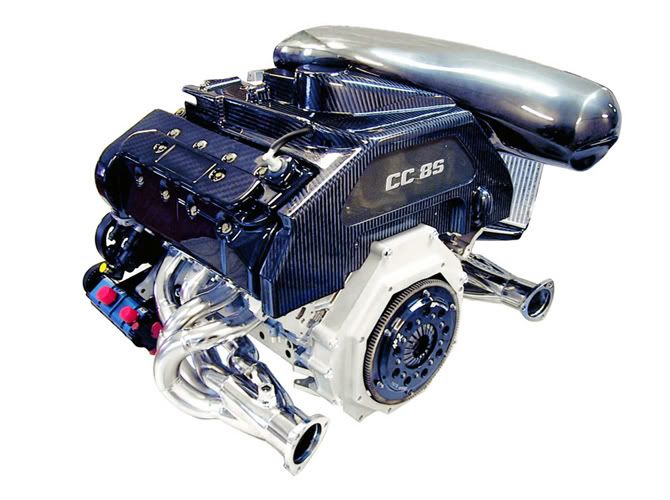
THE CCR ENGINE: INTRO GENERAL DATA
The Koenigsegg CCR is powered by a bespoke supercharged eight cylinder engine, specially developed by the Koenigsegg engineering crew for use in the CCR.
Its pure racing performance power and torque have been achieved whilst maintaining the low weight and superb drivability of the car. The 806 hp Koenigsegg CCR currently holds the Guinness World Record for the most powerful car in series production.
The CCR engine delivers 806 Hp at 7000 rpm and 920 (550 ft-lb) Nm of torque at 5,400 rpm. It is a state-of-the-art Quad Cam semi-stressed V8 construction with a 4.7 litre displacement and 32 valves. The CCR is boosted to its extreme power output by a unique Bi-compressor Supercharging system, which employs twin centrifugal compressors to enable a 1.4 bar maximum boost pressure at 5000 RPM. This system significantly increases power and torque across a broad rev band, and it also includes the revolutionary Koenigsegg RBC-System (Response Boost Control) (pat. pend), which completely obliterates on-off throttling lag time.
Another novel and vital part of the CCR engine is the minimum drag Koenigsegg DFCC-system (Dynamic Flow Catalytic Converter), nicknamed the “Rocket Cat”, which ensures minimal exhaust back pressure despite allowing for a highly efficient filtering of emission gases. This technological feat cannot be overstated; no competitor has come close of creating an engine configuration with a power output of as much as 806 Hp, yet still keep exhaust gas emissions below certifiable levels.
KOENIGSEGG BI-COMPRESSOR SUPERCHARGING SYSTEM
The Bi-compressor Centrifugal Supercharging System features twin parallel mounted Rotrex compressors, which cooperate in generating the 1.4 bar boost pressure needed to create the colossal 806 Hp output. The innovative Danish Rotrex compressor represents the next generation of centrifugal superchargers; they exhibit a higher energy-efficiency level than any other, they are operational at higher RPM levels and also feature a new and completely silent ball bearing planetary drive system.
Due to its 80% energy-efficiency, the amount of energy consumed by the compressor is returned with both a quicker and greater build-up of air pressure. The general difference when compared to alternative supercharging systems is about 10 % in efficiency, however the increase in the low end of the rev band is even greater, putting the boost pressure of the Rotrex compressor above that of any screw compressor in the RPM range of interest to performance driving. Also the very high RPM capability (120 000 RPM) of the Rotrex turbine itself allows for an extremely high maximum air pressure very early in the rev band (1.4 bar at 5000 RPM), in all creating a spread of power and torque across the rev band unmatched by any competitor.
Koenigsegg’s engineers choose to equip the CCR with a dual set of specially adopted smaller Rotrex compressors, for several good reasons. First and foremost; a smaller compressor is operational at a broader RPM range, bringing greater boost pressure at both low and high revs. This is due to complex aerodynamics around the turbine; at low RPM a greater boost is obtained since fewer pockets of air is allowed to slip through unpacked by the rotor blades. At the high rev end the smaller diameter of the rotor blades brings down the speed at which the tips of the blades collides with the air, a speed that cannot be allowed to reach near speed of sound, at which efficient compression is no longer possible.
Using twin parallel Rotrex compressors means a doubling of these small size benefits; double the effect of low rev pressure, double the quantity of air that is propelled into the intercooler at any given point during acceleration, and also a far greater maximum boost pressure. The loss of energy suffered by pulling an extra compressor is minimal, amounting to less than 1.5 % of the total kinetic energy.
Though equal in size and weight to traditional turbo chargers, the twin Rotrex compressor lay-out, combined with the innovative Koenigsegg Response Boost Control (RBC) system, creates a model for supercharging with equal efficiency to any exhaust driven turbo configuration, and that with absolutely zero throttling lag time.
KOENIGSEGG RESPONSE BOOST CONTROL SYSTEM
Koenigsegg has developed the revolutionary RBC-system (Response Boost Control) to further increase the efficiency and drivability of the CCR engine. The RBC-system, which is currently being patented, aims to not only reduce, but completely eliminate response lag time at on-off throttling at any RPM or gear. In doing so, the RBC-system actually increases the energy-efficiency of the engine, and also optimizes the function of the supercharging system.
The Koenigsegg RBC-system replaces the traditional by-pass valve with an extra throttle, mounted before the compressors. This throttle is operated by an automatic vacuum sensor, which shuts it immediately at off throttling, thus effectively hindering a dangerous build-up of overpressure between the compressor and the main throttle.
The by-pass valve is a necessary component in all other supercharged engines. It releases compressed air back into the air intake at off-throttling to prevent damage to the intake system due to extreme overpressure, and to avoid excessive drag on the crankshaft i.e. extra energy/fuel consumption. Yet the conventional by-pass solution has several disadvantages; the released air takes with it a lot of energy that is lost to the engine, and while decompressing in the intake, this hot air heats up the fresh air, reducing the efficiency of the compressor and intercooler. More importantly to the drivability of the car, the common by-pass method induces unavoidably a certain lag in the response time at throttling. This lag is equivalent to the time it takes to rebuild the lost boost pressure at every gear shift or braking.
The RBC-system provides an equally simple and ingenious solution to this problem; the vacuum controlled extra throttle conserves a batch of pressurized air to feed the engine, giving it an initial boost at on throttling. Also it creates a low-pressure zone before the compressors, which allows the turbines to spin more freely with minimal resistance. In total this system ensures that at no point in any on-off throttling sequence, the engine is without a supply of charged air, therefore no lag time will be experienced by the driver.
In order to control both the maximum boost pressure and the amount of accumulated pressure at off throttling, the RBC-system is highly adjustable. A simple device ensures that the automatic vacuum throttle can be set to open at different times relative the main throttle. Also the total amount of intake air can be altered, so that the maximum boost pressure is reached early in the rev band, and that a constant maximum pressure is maintained while the engine is revving up.
THE DYNAMIC FLOW CATALYTIC CONVERTER SYSTEM
Regulations on emission levels in most countries have made it necessary to equip cars with highly efficient catalytic converters. Naturally, an engine with a greater power output will produce more exhaust fumes, which requires larger and better catalytic converters. In the most extreme supercars this is a huge problem, since these very large cats obstruct the flow of exhausts, creating a lot of unwanted back pressure. The cost in horsepower output is enormous. This is one major reason why it is such a challenge to build a street-legal car with more than 700 Hp.
The 806 Hp CCR engine is supplemented with an advanced exhaust system, which incorporates a brilliant solution to the back pressure problem; the Koenigsegg DFCC-system (Dynamic Flow Catalytic Converter). It brings down the back pressure in the manifolds from 1.2 to 0.3 bar at full power, making the gases pass through the exhaust with minimal loss of energy. Other advantages with this system are; improved emission cleaning, a built-in pre muffling capability saving weight and space, and also a built-in heat screen that keeps down engine bay temperature.
The Koenigsegg DFCC-system, nicknamed the “Rocket Cat”, consists of a cylindrical box that contains both the pre-cat and the main cat. A merge collector streamlines the exhaust from the manifold before shooting it into the “Rocket Cat” box. A precisely measured pipe guides the fumes towards the pre-cat, which therefore is activated quicker at start-up. The pre-cat is mounted so that it is surrounded by air, which allows excess fumes to spill over and bypass the pre-cat at high flow rates. This way, when the engine runs at higher revs, most exhaust gases will flow only through the main cat, ensuring that the obstructing pre-cat is used as little as possible, and is not damaged at high RPM and output. This result in very low back pressure compared to traditional systems.
Additionally, the dynamic flow within the “Rocket Cat” box serves to pulverize the sound waves from the engine, in effect acting as a pre-muffler that makes possible a smaller and lighter main muffler. The heat screen effect is due to the insulating layer of air that surrounds the pre-cat, which makes sure that the heat stays within the pipe. This facilitates both better catalytic effect in the main cat and a lower engine bay temperature.
THE CCR ENGINE: GENERAL SUPPLEMENTARY DATA
The all aluminium 4.7L Koenigsegg V8 is built to cope with extreme stress during racing conditions; the CCR engine is equipped with dry sump lubrication, stainless valves, forged oil cooled pistons and connecting rods, complemented by bespoke camshafts designs and an exceptionally strong forged crankshaft manufactured by Gerlach Werke in Germany, known for their high quality and outstanding performance.
The CCR air intake system incorporates twin Rotrex centrifugal superchargers equipped with the Koenigsegg patented Response Boost Control system, coupled to a custom-built intercooler that lowers the charged intake air temperature from 150 C to 50 degrees C. This system enables a 1.4 bar maximum boost pressure and a compression ratio of 8.6:1.
A specially manufactured dry-sump engine lubrication system enables a low frame position, and subsequently a very low centre of gravity. A Koenigsegg engineered unique oil spray device provides efficient cooling for the pistons, thus adding to the durability and efficiency of the engine. The twin pump return fuel system with its large bore extruded aluminium rails ensures efficient and fail safe supply of fuel to the engine. The CCR engine's fuel supply system is designed to feed the engine up to well above 1000 hp.
Direct coil on-plug ignition and a fully compliant OBD II computer system guarantees an effective and stable combustion, making the engine reliable and low on emission levels. Upon request a distance monitoring uplink can be installed, which is a great tool for maintenance and service.
The CCR exhaust system is made of stainless steel and incorporates equal length tube headers and dual merged collectors. The Koenigsegg DFCC catalytic converter system effectively assist the engine in reducing emissions to certifiable levels, while at the same time support the high power output level. This exhaust system is designed for minimize exhaust drag beyond that of any comparable engine set-up.
The CCR engine is made of super lightweight materials, e.g. aerospace specified aluminium alloy, titanium and carbonfibre. The engines are equipped with carbonfibre valve, timing and front covers, which reduce overall weight by about 12 kg. Additionally, all parts of the highly efficient induction type air intake system are made of carbonfibre. It is a complex series of ducts and tanks, organically shaped to maximize the flow of air into the engine. The total weight of the Koenigsegg CCR engine is as low as 215 Kg.
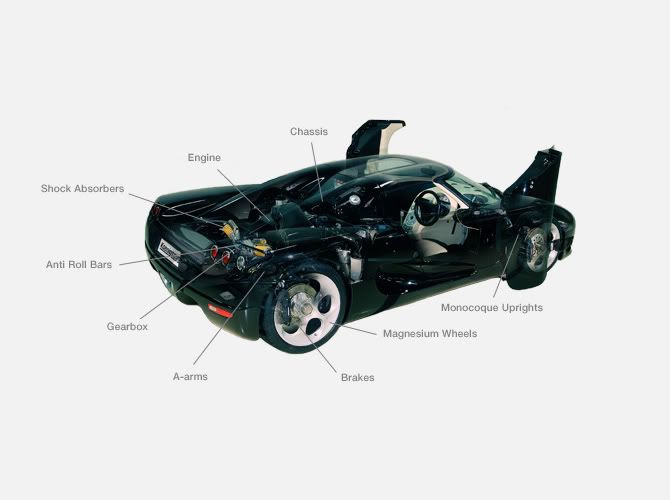

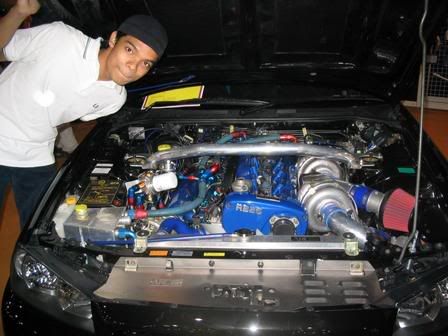
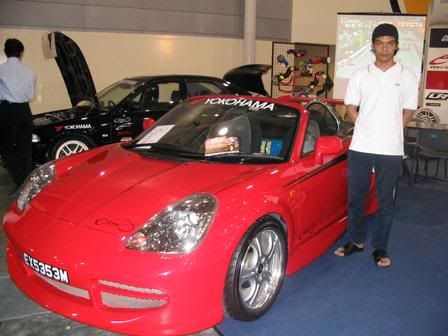
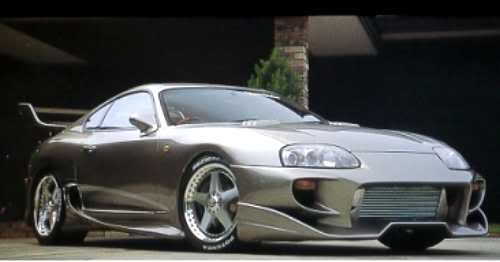 A site For All u Car lovers..........
A site For All u Car lovers..........